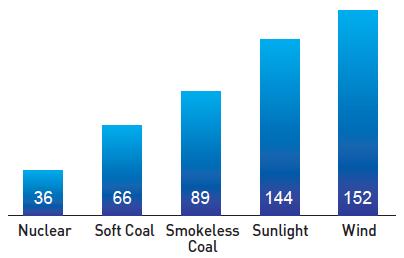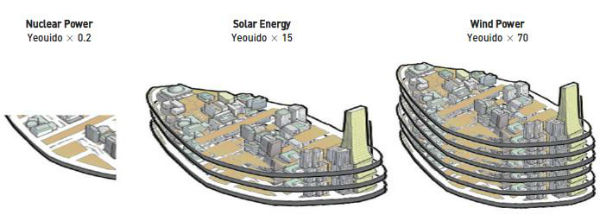Diverse global issues
Nuclear energy was invented by Enrico Fermi, an Italian physicist, in 1942. It brings about a lot of issues because it is like a double-edged sword. It has a lot of strong points, thanks to its economics, environmental effect, and effectiveness. These strong points make nuclear energy one of the most popular types of energy in existence. It also has fatal weaknesses, though. For one, it has explosive power and radioactivity. Maybe all of you already know that it is feared by many because of the catastrophic effects of the atomic bombings of Hiroshima and Nagasaki in 1945, during the Second World War. As a result of this event, 70% of the structures in such cities were destroyed, and 90,000-166,000 of the 350,000 inhabitants of the cities were killed. Also, according to a study, nearly 9% of the people in such cities who died of cancer and leukemia until 1990 were victims of such bombings. For Nagasaki, the damage was relatively smaller, with the number of
victims totaling 80,000.
Chernobyl nuclear accident
The atomic bombings of Hiroshima and Nagasaki were only the beginning. In 1986, the Chernobyl nuclear accident, dubbed “the biggest and worst accident of the 20th century,” occurred in the Soviet Union (presently a territory of Ukraine). A total of 31 people were immediately killed, and 70,000 people additionally died later. An additional 70,000 victims were treated for burns and radioactivity. Furthermore, a huge amount of radioactivity was released into the atmosphere and was spread all over Europe and some parts of Asia through the climate change. As a result, some European countries prohibited the distribution of milk and vegetables. Also, many researchers said that the rates of cancer and birth defect cases would certainly increase. This accident became an issue because of the relaxed measures taken by the Soviet Union after the incident. The government ordered the residents to evacuate from the town after 36 hours. In addition, the Labor Day Parade was held as planned at Kiev, the capital of Ukraine. The place where the accident occurred was just covered with mass concrete, and Chernobyl Nuclear Power Plant was fully closed only in 2000. Now, many of the villages situated around such plant are already ghost towns. Also, the forest of Chernobyl has turned red due to the radioactivity, and many deformed creatures have been observed. It has become the “ground of death.”
Fukushima nuclear accident
In March 2011, the already-existing negative view about nuclear power plants was magnified. An magnitude 9.0 earthquake and a massive tsunami occurred in eastern Japan. The great earthquake and massive tsunami struck Fukushima. As a result, 12,000 people were killed by the disaster, and 15,000 people disappeared. This was not the end of the story, though. The disaster also struck the Fukushima Nuclear Power Plant, causing consecutive explosions therein. The explosion had a
tremendous effect on the ground and waters of Fukushima. It caused much radioactivity to permeate the ground and waters. Thus, nearly 110,000 people lost their homes and left their hometown to find a new residence because Fukushima had been contaminated by radioactivity. This major incident in Japan was recorded as level 7, the most dangerous level and the same level as the Chernobyl nuclear accident. The radioactive substance that had been released at that time spread all over the world through the westerlies, and to this day, the Fukushima accident is still in progress. It will probably take a long time to recover from the accident, as with the Chernobyl accident. Nobody knows when such horror will finally end, but the accident made the whole world realize again the dangers posed by nuclear power plants.
Germany’s nuclear power plant closure
According to the German government, all of Germany’s nuclear power plants will be closed by 2022. This decision was influenced by the Fukushima nuclear accident. When the accident took place, many Germans felt uneasy about their nuclear power plants. This anxiety gradually expanded and caused an opposite public opinion about nuclear power plants. As a result, the German government decided to immediately close seven Nuclear power plants that were already more than 30 years old, and to completely shut down it’s other nuclear power plants. Also, Germany said that it will cope with the energy gap that will result from such move by conducting a study on renewable
energy and addressing the weaknesses of such energy so that it can be considered for use.
The birth of nuclear power


Nuclear power generation isn’t different from thermal power generation in that water is boiled and steam is made, which spins the turbine. The only difference between the two is that nuclear power boils the water with the heat released during uranium splitting. The Obninsk Power Plant of the old Soviet Union, which started its operations in June 1954, was the first plant in the world that generated electricity from nuclear power. The operation of the Gori Unit. 1 reactor in April 1978 made
South Korea the 21st country in the world to possess a nuclear power plant. South Korea is currently ranked 6th in the world in terms of installed capacity. The biggest reason for South
Korea’s establishment of the nuclear power plant was the 1970s’ worldwide oil shock. The Park Jung-hee administration built the first power plant in South Korea with the technical cooperation of the U.S. during the Syngman Rhee administration. There was a time when nuclear power accounted for 40% of the country’s generated electricity, but it currently accounts for only 30%. With South Korea’s goal of producing 40% of the country’s electricity needs, the new nuclear power plant
was ambitiously constructed. In view of the country’s limits in term of natural environments,
including the mountains covering 70% of the country and the country’s water shortage, nuclear power is the most acceptable alternative means of addressing the country’s electricity needs until the time when new and renewable energy sources can already generate a large amount of electricity.


The illusion called “safety”
We live in South Korea, where nuclear power plants stand only 300kms from the capital area. The government and KHNP(Korea Hydro & Nuclear Power Corporation) continually assure people, telling them that we are living on safe land. Can we count on their assurances? A month after the Fukushima Nuclear Power Plant explosion, the operation of Gori Power Plant Unit 1 was stopped to repair a defective part of the circuit breaker. On average, the nuclear power plant was down 8.7
times a year for the last 10 years. Since the first nuclear power generation of the Gori Unit. 1
reactor in 2011, South Korea has recorded a total of 651 nuclear accidents. There have been 13 level 1 and two level 2 accidents. The rest have been level 0 accidents. During the trial operation of the new unit 1, designed with the newest technology in Gori, a level 2 accident occurred. Although KHNP indicated in its promotional pamphlet that its power plant “has safety measures in place and has never had any radiation leak or has never figured in an accident where people got injured,”
the fact that level 2 accidents happened in 2010 and 2012 means that there was radioactive contamination in the facility.
Japan Nuclear Mafia and South Korea
In 1988, Kansai Electric Power Company in Japan established a connection with the local Yakuza and hired minors through a forged report. At present, some local gangsters are suspected of hiring day laborers to work in the devastated Fukushima Nuclear Power Plant. The fact that the company has real gangsters, however, is not the main reason that it was called “Nuclear Mafia.” Electric power corporations like TEPCO (Tokyo Electric Power Corporation) are monopolizing the electric power generation business. Corporations enforce parachute personnel management to tame the government officials. The recruitment of retired politicians became a custom. In Japan, 68 bureaucrats got jobs as executives in electric corporations in a span of over 50 years. TEPCO takes measures involving the political world. The company’s executives gave political contributions to the Liberal Democratic Party (Ja-Min-Dang) and are financing the labor union. Influential politicians were given private funds. The academy is also strongly influenced through the cutting of
its support funds. In these ways, the Nuclear Mafia, seizing politics and the academia, is blocking all the concerns about nuclear energy. The consequence is information monopoly by the government and the electric company. Alarmingly, the one most alike Japan nuclear power group is South Korea. KHNP also takes all of responsibility for management, administration, and construction of new plant of nuclear power generation which produce 30% of total electricity. Furthermore, retired high ranking executives of KHNP were reemployed to companies in charge of designing, construction, organizing, and safety check of nuclear power plant. When ST visited the power plant, KHNP said about the scandal, “Strictly speaking, it was caused by our subcontractor, so it is not our responsibility. As the general manager, however, we, the entire office, apologize for this scandal.” KINS (Korea Institute of Nuclear Safety), the regulatory authority after the Fukushima disaster, still got half of budget from KHNP. The link between politics and corporation in South Korea is worryingly similar to Japan’s nuclear mafia.

Interviews 1
ST: What do you think about nuclear power?
Kim Min-jung (Economics, 12) : I have a positive view in regard to nuclear power plants. Nuclear energy accounts for nearly 30% of South Korea’s generated power. Also, it is very effective in the economic aspect. Thus, I wonder how we can substitute it if the plants are closed. We can replace nuclear energy with fossil energy to some degree, but using fossil energy is very inefficient because it has a negative effect on the environment and because its cost is gradually increasing. Therefore, I think we can’t live without nuclear power plants.
ST: Nuclear power plants pose a potential danger. What do you think about this danger? How can we cope with it?
Kim : When the Fukushima nuclear accident occurred, it did not catch my attention. I have never
experienced such an accident, and it is a matter concerning only Japan. Of course, I know that it is a very dangerous thing, but I can’t feel the danger. I think we should prepare to cope with the diffusion of radioactive material. When the nuclear power plant was founded, the government implemented soil investigation completely to prevent accidents. As a result of the investigation, South Korea is a very safe country geologically. Thus, if we prepare to prevent the diffusion of radioactive material, we will have no such problem.
Interviews 2
ST: What do you think of nuclear power plants, and why do you think that way of them?
Kim Sang-yun (Electronic Engineering, 12) : I don’t like nuclear power plants. As you know, they are very effective in the economic aspect, but they also have a very high risk. We know how dangerous they are from the Chernobyl and Fukushima accidents. A nuclear power plant is like a time bomb; nobody knows when it’s going to explode. Therefore, I don’t agree with the South Korean government in regard to its policy on nuclear power plants.
ST: How can we cope with the electric power shortage?
Kim : Nuclear power plants account for a large percentage of South Korea’s energy supply. If we close all the nuclear power plants in South Korea, a serious electric power shortage will certainly occur. I think, however, that we can cope with such problem. We can learn much about how to do this from Germany. First, we have to save energy. We can save a large amount of energy in little ways like turning off the lights that you won’t use. Also, we should make an effort to develop new and alternative energy sources. Then we can close our nuclear power plants one by one without any problem.


